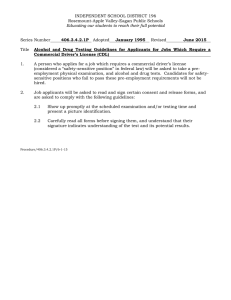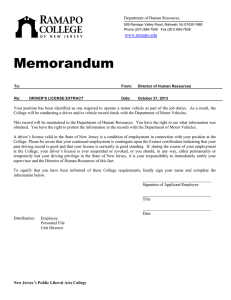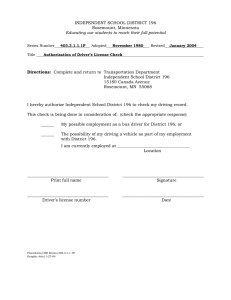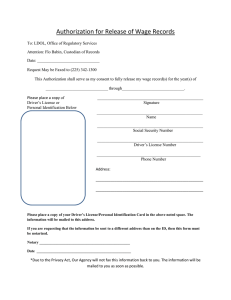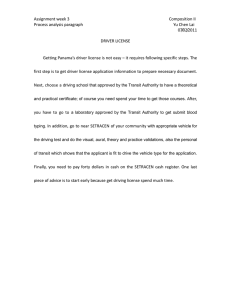Religious Accommodation in Driver`s License Photographs: CAIR
advertisement
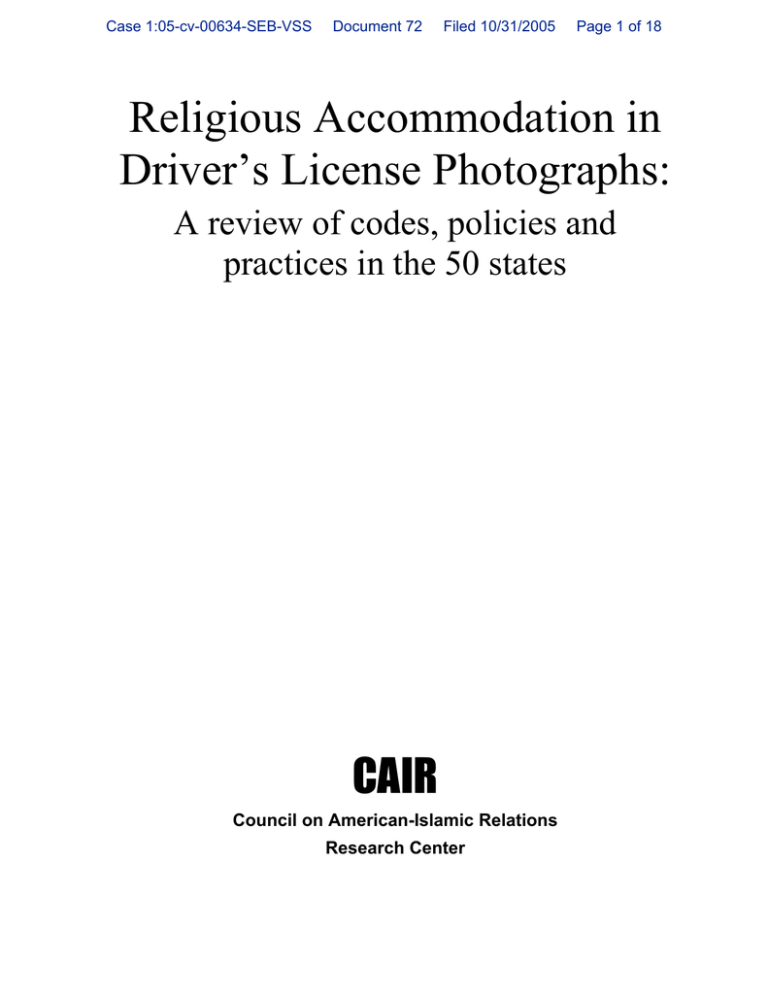
Case 1:05-cv-00634-SEB-VSS Document 72 Filed 10/31/2005 Page 1 of 18 Religious Accommodation in Driver’s License Photographs: A review of codes, policies and practices in the 50 states CAIR Council on American-Islamic Relations Research Center Case 1:05-cv-00634-SEB-VSS Document 72 Filed 10/31/2005 Page 2 of 18 CAIR Research Center produces educational pamphlets, reports and papers on the American Muslim experience. Dr. Mohamed Nimer is the director of research. Acknowledgements: A number of individuals helped in the compilation of the information necessary for the production of this publication. Laurie Jaghlit and Rizwan Qureshi wrote letters to departments of motor vehicles to request information on religious accommodation policies with regard to photograph requirements. CAIR interns Tayyiba Qureishi, Muhammad Sabur and Muhammad Sallam helped in follow up and preparation of policy summaries. To obtain copies of this report, contact: Council on American-Islamic Relations 453 New Jersey Avenue, S.E. Washington, DC 20003 Tel: 202-488-8787 Fax: 202-488-0833 E-mail: cair@cair-net.org URL: http://www.cair-net.org 2004 Copyright, Council on American-Islamic Relations No part of this publication may be stored in a retrieval system, transmitted, or reproduced in any way, including but not limited to, photocopy, photograph, and magnetic or other record, without the prior agreement and written approval of the publisher. 2 Case 1:05-cv-00634-SEB-VSS Document 72 Filed 10/31/2005 Page 3 of 18 Executive Summary Over the years CAIR has received numerous reports from driver’s license applicants claiming that they were denied religious accommodation. CAIR has obtained public records from driver’s license agencies in all states. This review reached the following findings: 9 Religious accommodation issues impact men and women in the Christian, Jewish, Sikh, and Muslim communities. 9 Most states, except Georgia, Kentucky and New Hampshire, have addressed religious accommodation concerns in codes, policy manuals or administrative practices. 9 Five states—Arkansas, Mississippi, Kansas, Missouri, and Maine—recognize only certain religious practices. 9 The other 42 states have adopted more inclusive approaches to religious accommodation policies. 9 Contrary to earlier news reports, the trend in favor of religious accommodation increased after 9/11. While three states—California and the Carolinas— scaled back some of their religious exemptions, six states—Alabama, Maine, Oklahoma, Texas, Utah, and West Virginia—increased the exemptions. Recommendations 1. Departments of motor vehicles in Georgia, Kentucky and New Hampshire should enact rules for the purpose of preventing unnecessary denial of religious accommodation to driver’s license applicants. 2. Arkansas, Mississippi, Kansas, Missouri, and Maine should become more inclusive in their religious accommodation policies. 1 Case 1:05-cv-00634-SEB-VSS Document 72 Filed 10/31/2005 Page 4 of 18 Introduction Members of some faith groups follow certain religious practices that may require them not to reveal parts of their body in public or not to be photographed at all. Driver’s licensing procedures are often very specific about what parts of the face and head should be exposed when applicants are photographed. In 2003, CAIR began inquiring about state laws and policies regarding religious accommodation issues at departments of motor vehicles. Most concerned citizens While coping with America’ growing diversity is a public interest, regulations specifying photo requirements for driver’s license applicants affect the following five categories of individuals most directly: 1. Christians who maintain a religious objection to being photographed; 2. Jewish and Muslim men who wear caps for religious reasons; 3. Christian, Jewish, Muslim and Sikh women who wear head covering for religious reasons; 4. Sikh men who wear turbans for religious purposes; and 5. Muslim women who wear face veils for religious reasons. Religious practices and photo procedures Headgear Typically, state laws and procedures used to require the exposure of the head before taking driver’s license or identification card photographs. Forty-six states passed laws or enacted administrative policies addressing the religious needs of applicants with headgear. Most states provide for religious/cultural exemptions Thirty-five states exempt religious or cultural headgear from the requirement to expose the hair. These states are: Alabama, Alaska, Arizona, California, Colorado, Connecticut, Florida, Hawaii, Idaho, Illinois, Indiana, Iowa, Louisiana, Maryland, Massachusetts, Michigan, Minnesota, Mississippi, Missouri, Nebraska, Nevada, North Carolina, North Dakota, Ohio, Oklahoma, Oregon, Pennsylvania, Rhode Island, South Carolina, South Dakota, Tennessee, Vermont, West Virginia, Wisconsin, and Wyoming. Some states recognize religious headgear as normal wear Minnesota, New Jersey, New York, Texas, Utah, Virginia, and Washington do not view religious headwear as an exception that need to be addressed, but as a normal variation that is recognized and respected. Several states are silent on the issue Georgia, Kansas, Kentucky, and New Hampshire do not have laws or regulations regarding headgear in driver’s license photos. 2 Case 1:05-cv-00634-SEB-VSS Document 72 Filed 10/31/2005 Page 5 of 18 Objections to being photographed There are sharp distinctions in the way state agencies have approached this matter. Several states allow for a no-photo driver’s license Thirteen states allow a no-photo driver’s license option, in deference to customers who have religious objections to being photographed. These states are: Arkansas, Indiana, Kansas, Minnesota, Missouri, Nebraska, New Jersey, North Dakota, Oregon, Pennsylvania, Tennessee, Washington, and Wisconsin. Some of these states have a concentration of Amish and Mennonite Christians—who hold the belief that Bible teachings do not allow them to be photographed. Three states do not allow the no-photo option These states are California, North Carolina and South Carolina Most states are silent on the issue All remaining thirty-three states do not address this issue of religious accommodation. Face veils Departments of motor vehicles vary considerably in their treatment of veiled women. Many states do not allow pictures with face covering The following twenty-two states fall in this category: Alabama, Colorado, Delaware, Florida, Georgia, Hawaii, Idaho, Illinois, Kentucky, Louisiana, Massachusetts, New Jersey, New Mexico, New York, North Carolina, Oklahoma, Oregon, South Dakota, Utah, Virginia, Wisconsin, and Wyoming. Many states are silent on the issue Nineteen states are included in this category. These are: Alaska, Arkansas, Connecticut, Georgia, Iowa, Kentucky, Maine, Maryland, Minnesota, Mississippi, Missouri, Nebraska, New Hampshire, North Dakota, Ohio, Rhode Island, Tennessee, Texas, and Vermont. Several states offer specific accommodations Nine states fall into this category. South Carolina, Michigan and West Virginia allow veiled women privacy in taking a fullfaced picture. Kansas, Pennsylvania and Indiana allow veiled women a no-photo driver’s license. Montana exempts religious veils from the requirement of a full-faced picture. Washington allows pictures of veiled women, but stipulates that such driver’s licenses are not valid for identification purposes. Nevada allows photos with “drastic alteration of appearance.” Verification of religious beliefs Out of the forty-seven states with regulations on religious accommodation, only nine require some verification of beliefs and practices. The other states do not even consider this to be an issue. In fact California and Pennsylvania rule out this requirement. Some states require a written statement to verify beliefs These states are: Connecticut, Hawaii, Idaho, and Kansas. 3 Case 1:05-cv-00634-SEB-VSS Document 72 Filed 10/31/2005 Page 6 of 18 Two states demand an affidavit signed by witnesses Only Nebraska and North Carolina fall in this category. Two states require a notation on the application form Arizona and Montana instruct clerks to make such notations. Several states grant discretionary power to clerks Alaska, Rhode Island, and Vermont leave the validation of religious accommodation requests to clerks and supervisors in charge of processing applicants. Levels of legal authority Departments of motor vehicles addressed the diversity issue discussed in this publication with various levels of authority. Laws The following ten states passed legal codes: California, Georgia, Idaho, Illinois, Kentucky, Michigan, Missouri, Hew Hampshire, Oregon, and Wisconsin. Agency policies The following thirty-one states adopted agency wide policies: Alabama, Alaska, Arizona, Arkansas, Colorado, Florida, Hawaii, Indiana, Iowa, Kansas, Louisiana, Maine, Maryland, Massachusetts, Mississippi, Montana, Nebraska, Nevada, New Mexico, New Jersey, New York, North Carolina, North Dakota, Ohio, Oklahoma, Pennsylvania, Tennessee, Utah, Vermont, Virginia, and Washington. Personnel directives The following four states handled the issue through memoranda passed from agency heads to clerks: Connecticut, Rhode Island, Texas, and West Virginia. Non-official practices The following three states have no official rules but tend to follow certain patterns of practice: Delaware, South Carolina and South Dakota. Impact of 9/11: Many states revised their procedures regarding driver’s license photos after September 11, 2001. The most noteworthy changes are: California, North Carolina and South Carolina terminated the no-photo driver’s license option. In the three states the rationale provided for this action was a broad reference to security needs and the environment after 9/11. Alabama, Maine, Oklahoma, Texas, Utah, and West Virginia inserted provisions allowing religious headgear. Connecticut and Idaho added the requirement of written verification to applications with religious accommodation needs. New Jersey allowed pictures with face covering at first, but quickly rescinded this new procedure. 4 Case 1:05-cv-00634-SEB-VSS Document 72 Filed 10/31/2005 Page 7 of 18 What is the compelling interest of the state? The legitimate public interest in the matter of driver’s license photos is traffic law enforcement. Simply, a police officer must be able to make sure that drivers are the same persons presenting the proof of their driving privilege. The requirement of a digital picture serves this purpose. Conclusion Driver licensing agencies deal with three major issues of religious accommodation: (1) religious headgear; (2) face veils; and (3) religious objections to being photographed. All states but three address at least one of these issues. All but a few states offer accommodation for headwear, which reflects increased tolerance and perhaps recognition of the fact that hair is not a reliable identifier—as its appearance and color can be easily altered). Contrary to recent news reports, the trend to accommodate headgear grew after 9/11. However, the states of Georgia, Kansas, Kentucky, and New Hampshire do not address religious accommodation issues in their rules or practices. Ten states offer specific accommodation to the religious objection to taking pictures. California and the Carolinas had such a policy until 9/11. The rest of the states are silent on the matter. A plurality of the states either offer accommodation or are silent on face coverings in driver’s licensing procedures. Twenty-one states do not allow pictures with face covers. Pennsylvania and Washington acknowledge that a driver’s license need not be seen as a form of identification. A no-photo option would accommodate both groups of Christians and Muslims. To positively identify drivers with no-photo licenses, states can issue identification cards with fingerprints. Technical advancements, such as portable fingerprint detectors, used now in computer security systems, may be adapted to law enforcement needs. If this is possible, a driver’s license can carry a fingerprint image instead of a digital face picture. 5 Case 1:05-cv-00634-SEB-VSS Document 72 Filed 10/31/2005 Page 8 of 18 Policy Summaries Alabama Policy: A new procedure states that: “The photograph of each applicant must be a ‘full face’ photo. Head coverings and headgear are only acceptable due to religious beliefs or medical conditions, and even then, may not obscure any portion of the applicant’s face. … Photographs of applicants wearing headgear not specifically religious in nature are not acceptable. A photograph shall not be taken depicting a person wearing a traditional facemask or veil that does not permit positive identification.” Source: Alabama Department of Public Safety. Proposed Promulgated Rule (Released, February 20, 2004). Alaska Policy: Associates of the Division of Motor Vehicles are instructed: “Use discretion with applicants wearing hats or other head wear. Head wear for religious purposes is permissible.” Source: Alaska Division of Motor Vehicles. Standard Operating Procedures (Effective, November 22, 1994). Arizona Policy: The applicant “is not allowed to have a head or face covering except a beard or mustache…. [H]ats, scarves, headbands, sun glasses, etc., are only allowed for religious or medical reasons. If this occurs, make a notation on the application.” Source: Arizona Motor Vehicle Division. Policy and Procedure (Effective, August 18, 1995). Arkansas Policy: “We don’t allow applicants to wear hats when being photographed for a license…. The only exception to this procedure is for women of the Muslim religion. Since their religion prohibits them from appearing in public without headcover, we allow them to be photographed with their religious headcover.” Arkansas also provides for a no-photograph driver’s license if applicants object to being photographed for religious reasons or are physically or geographically unavailable to be photographed. Source: State of Arkansas Department of Finance and Administration, Driver Services Administration Procedures, n.d. California Policy: “A license shall bear a full face engraved picture or photograph of the licensee…. The DMV in the state of California wants to be sensitive to the needs of all applicants and does allow headgear to be worn because of religious beliefs provided it does not obscure the applicant’s facial features. However, it may be necessary to ask the licensee to push back the headgear to eliminate dark shadows on his/her face. No written statement 6 Case 1:05-cv-00634-SEB-VSS Document 72 Filed 10/31/2005 Page 9 of 18 from the applicant is necessary regarding the wearing of the headgear. The applicant’s verbal statement is sufficient.” Source: California Vehicle Code, Sections 12800-5 and 13005. Colorado Policy: “No hats, headwear, decorative scarves or ‘do-rags’ are allowed in the photograph, for either men or women, except for religious reasons…. Religious veils are not allowed…. The headwear may remain but the veil across the face must be removed.” Source: State of Colorado Department of Revenue, Motor Vehicle Business Group, Driver License Section. Basic Fingerprint, Signature and Photo Procedures, July 29, 2003. Connecticut Policy: A Department of Motor Vehicles memo reads: “Please be advised that effective immediately applicants for operator licenses that wear head coverings for religious reasons will be allowed to keep the head covering on while being photographed. The applicant must sign an oath attesting to the religious requirement. Other head coverings must still be removed such as baseball caps, cowboy hats, etc., as well as dark glasses. The statement of oath reads: “I declare under penalty of false statement that my religious beliefs require my head covering to remain on while in public or while being photographed.” Source: State of Connecticut Department of Motor Vehicle Branch Operations. Memorandum, August 27, 2002 and Statement of Oath, n.d. Delaware Policy: Delaware code and administrative procedures on motor vehicles do not address issues regarding the religious diversity of customers. In practice, however, the Division of Motor Vehicles requires “all photographed to be full faced and unobstructed. This enables the photograph on the license to be used as a means of proper identification for motor vehicle, emergency and public safety purposes. Although a written policy is not presently in place, such an idea is under consideration.” This clarification was provided by the Governor’s Office in response to a public records request. Source: Letter from Bernard Pepukayi, September 17, 2004. District of Columbia Did not respond to a Freedom of Information Act (FOIA) request. Florida Policy: “Section 322.142(1), F.S., requires a full facial photograph or digital image of the licensee. Hats or head coverings, covering the head only (not the face) are permissible if required for religious or medical reasons.” 7 Case 1:05-cv-00634-SEB-VSS Document 72 Filed 10/31/2005 Page 10 of 18 Source: Florida Department of Highway Safety and Motor Vehicles. Examiner’s Manual (Revised, March 18, 2003). Georgia Policy: “In accordance with O.C.G.A. § 40-5-28, all driver’s licenses shall bear a color photograph of the licensee. Specifically, all applicants are to be photographed, with no part of the applicant’s face covered.” Source: Rules and Regulations of the State of Georgia, Title 570, Chapter 570-3 (Revised, October 1, 2002). Hawaii Policy: “Applicants shall remove any hats, head-dress, etc. so as not to obscure more than two-thirds (2/3) of their full-faced photograph. The only exception to the removal of headgear will be based on ‘religious beliefs’… these [exempted] applicants shall submit a written explanation as to why he/she is unable to comply, including furnishing the name and sect of his/her religious belief.” Source: Department of Finance of the City and County of Honolulu. Rules and Regulations of the Director of Finance, Part 30. Idaho Policy: “The photograph shall be taken without headgear or other clothing or device that disguises or otherwise conceals the face or head of the applicant. A waiver may be granted by the department allowing the applicant to wear headgear or other head covering for medical, religious or safety purposes so long as the face is not disguised or otherwise concealed.” The waiver will be considered pending a written statement from “an established and recognized religious order” verifying the authenticity of the religious belief and that applicant is a practicing member of the order. Source: Idaho Code, Section 49-315; Idaho Department of Transportation Driver Services, Memo, March 12, 1990. Illinois Policy: “A full-faced photograph must be taken without any obstruction of the applicant’s facial features or any items covering any portion of the face. Prescription glasses and religious head dressings not covering any areas of the open face may be allowed.” Source: Illinois Vehicle Code, Section 1030-90. Indiana Policy: “For religious reasons, any applicant may wear a head covering or scarf, but the face cannot be covered or obstructed in any manner. If any head covering, scarf or veil covers the face for religious reasons, have the customer apply for a photo-exempt license or identification card.” 8 Case 1:05-cv-00634-SEB-VSS Document 72 Filed 10/31/2005 Page 11 of 18 Source: Bureau of Motor Vehicles. Procedure for Taking a Picture, n.d. Iowa Policy: “Hats, scarves, etc. of any kind or style will not be permitted. Exceptions may be considered for headwear required for religious or cosmetic purposes.” Source: Iowa Motor Vehicle Department. Driver’s License Examiner Manual, March 6, 2003. Kansas Policy: “Any person belonging to a religious organization which has a basic objection to having their picture taken may sign a statement to that effect and such person shall then be exempt from the picture requirements of this section.” Source: Kansas Department of Revenue, Division of Vehicles. Driver’s Licenses Policy, n.d. Kentucky Policy: “When taking the photograph, the applicant shall be prohibited from wearing sunglasses or any other attire that obscures any features of the applicant’s face as determined by the clerk. The clerk shall require an applicant to remove sunglasses or other obscuring attire before taking the photograph” Source: Kentucky Code, Section 186-412. Louisiana Policy: “Applicants shall have frontal photographs taken of the facial and neck area. Photographs shall be of such quality that full facial features will be shown and any distinguishing marks will be clearly visible. At no time will an applicant be photographed when it is obvious he is misrepresenting his/her gender and/or purposely altering his/her appearance in an effort which would ‘misguide/misrepresent’ her/her identity. Applicants will not be photographed with head covering such as hats, scarves or other adornments. The only exception to this will be any religious sect requiring head covering or any other attire. Applicants will not be photographed without blouses or shirts.” Source: Louisiana Department of Public Safety, Office of Motor Vehicles. Policy Section I, n.d. Maine Policy: An individual may be photographed wearing a turban or the customary wear of a nun. Headgear is also allowed for medical reasons. No other exceptions are provided. “No one will be allowed to wear a hat or other headdress when their photo is taken, except for a Nun who may wear the headdress as part of their ‘habit,’ or a turban may be worn in conjunction with religious beliefs. A person undergoing chemotherapy and requests to wear a kerchief, hat, etc., is allowed to do so.” 9 Case 1:05-cv-00634-SEB-VSS Document 72 Filed 10/31/2005 Page 12 of 18 Source: Maine Secretary of State Bureau of Motor Vehicles. Photo License/Identification Card Procedures Manual (Revised, February 6, 2003). Maryland Policy: “Applicants for driver licenses and identification cards who state that their head covering or habit is worn as a religious or cultural ordinance, practice, faith or belief, may be photographed according to procedures … while wearing the religious or cultural garment/head covering.” Source: Maryland Motor Vehicle Administration Driver and Vehicle. Policy Manual, n.d. Massachusetts Policy of Policy: An individual may be photographed wearing a head covering if it is worn for medical or religious reasons and it does not obstruct a clear view of the person’s face. The rule is very specific about defining what needs to appear on the photograph. “A head cover is used to cover the top of the head without obstructing a clear view of the person’s face.” A head cover is permitted so long as (1) it is worn for medical or religious reasons; and (2) It does not hide any of the following facial features: Eyes, nose, mouth, and cheeks. Face covers and glasses are not permitted. Source: Massachusetts Registry of Motor Vehicles, Training Update: Facial Image Policy (Revised, May 19, 2004). Michigan Policy: An individual may be photographed wearing a religiously-mandated head cover, as long as it does not touch the person’s eyebrows. If an applicant’s face is covered by fabric for religious reasons, exposing only the eyes, she will be requested to remove it before being photographed. The applicant will be offered the option of being photographed without her face veil by a female staff person. This procedure could only be done before or after usual business hours, and no male employee would be present. Source: Michigan Vehicle Code, Sections 28-292 and 257-310. Minnesota Policy: The full-face photo requirement is illustrated to licensing offices through a flier that has pictures of males and females with hats, headwraps, a turban, and a headscarf covering the hair and neck. The law also provides for a no-photo option to applicants who have religious objections to being photographed. A person with such an objection is required to sign a statement that the taking of a photograph and using it as a form of identification violate their religious beliefs. Source: Minnesota Code, Section 171-071; Minnesota Department of Public Safety, Driver and Vehicle Services. Minnesota Rules, n.d. 10 Case 1:05-cv-00634-SEB-VSS Document 72 Filed 10/31/2005 Page 13 of 18 Mississippi Policy: An individual may be photographed wearing a head cover for religious or medical reasons. Source: Mississippi Highway Safety Patrol Driver Services Bureau. Driver Services Policy, n.d. Missouri Policy: The state statute simply requires a colored photograph of applicants unless they have a religious objection to it, in which case a no-photo license can be issued. Source: Missouri Code, Section 302-181. Montana Policy: Motor Vehicle Division employees are instructed that “[a]n applicant’s full face must be visible when photographed. We are prohibited from taking photos of applicants while they are wearing a hat, scarf, sunglasses or veils with the exception of 1) medical purpose or 2) religious practices or beliefs require them to.” However, clerks are instructed “to record in correspondence the reason for the head covering. (i.e., medical or religious beliefs).” Source: Montana Motor Vehicle Division. Field Operations Policy Manual, n.d. Nebraska Policy: An individual may be photographed wearing a religiously-mandated head cover. Applicants must fill out a form to explain their religious beliefs that call for the head covering exemption. The form must be signed and notarized. A no-photo card is also permitted on religious grounds. Applicants will then be notified by mail if the exemption is granted. Source: Nebraska Department of Motor Vehicles. Application for an Exemption for the Photograph Style Relating to Head Covering and Application for an Exemption to the Photograph on a Nebraska Driver’s License, Permit and/or State Identification Card, n.d. Nevada Policy: Clerks must request “that applicants remove any hat, headgear or dark sunglasses. It is not necessary to insist, however [,] any item that drastically alters the appearance of the applicant should be removed.” Source: Nevada Department of Motor Vehicle policy 15.015, quoted in a fax from Tom Jacobs of Nevada DMV on August 7, 2003. New Hampshire Policy: State code requires “an instant full-face photograph.” The law neither recognizes nor denies the possibilities of religious accommodation needs. 11 Case 1:05-cv-00634-SEB-VSS Document 72 Filed 10/31/2005 Page 14 of 18 Source: New Hampshire Code, Title 21, Section 263-40. New Jersey Policy: “In the event a customer requests to be excused from the Law requiring an initial photo driver license because of religious convictions, you should provide him with a blank affidavit form…. When and if these executed forms are returned to your agency, be sure to review them for completion before accepting them. The affidavit form must be notarized and the attestation form [must be completed by a religious leader or minister]. If you are in doubt as to the authenticity of the attestation form, or if you wish one of our staff to review the completed forms, please contact your Regional Manager or the Agency Helpline…. In the event a customer requests his photo driver license be taken with a head covering because of religious reasons, you should provide him with a blank affidavit form…. In lieu of the notary requirement, this form may be signed by the Agent/Supervisor or his/her designated employee as witness.” The latest modifications of these instructions required clerks to contact superiors if they are presented with a request of no photo license. They also relaxed the requirement on head covering. “Customers may now be photographed with any type of head covering, provided that they first state their desire to do so. Ask the customer to remove their headgear, and if they object, due to medical or religious reasons, you may take the photo with the headgear in place.” In 2003, a memorandum reminded employees that “applicants who obtain photo driver licenses or ID cards are not required to remove religious or ethnic head and/or facial coverings. Also, the Division no longer requires that the applicants certify to the necessity of the coverings. Three weeks later another memorandum was issued disallowing the issuance of driver licenses to applicants wearing facial coverings of any kind. Source: New Jersey Department of Transportation Division of Motor Vehicle. Agency Procedures Manual, 1994 and 1997; Robert R. Grill. Memorandum, April 9, 2003 and May 28, 2003. New Mexico Policy: “an applicant is not permitted to wear in his or her photograph any item of clothing (such as a head cover) that interferes with or otherwise obscures identification of the individual. As an example, an applicant is not permitted to have an [Motor Vehicle Division] MVD photo taken if the applicant is wearing a head cover that revealed solely the applicant’s eyes but obscured all other facial features.” Source: Steven Dichter. Memorandum, May 14, 2004. New York Policy: Applicants are not asked to remove hats or any other headwear unless that apparel interferes with facial identification. Source: State of New York Department of Motor Vehicles. Commissioner’s Regulations, cited in a letter from Stephen Berletic, Director of Document Production, March 27, 2003. 12 Case 1:05-cv-00634-SEB-VSS Document 72 Filed 10/31/2005 Page 15 of 18 North Carolina Policy: “The Commissioner may waive the requirement of a color photograph on a license if the license holder proves to the satisfaction of the Commissioner that taking the photograph would violate the license holder's religious convictions.” Using this discretionary power, the Division of Motor Vehicle Commissioner suspended the waiver on November 6, 2001 until further notice, citing the “current public safety concerns” as a reason. The memorandum, however, reaffirmed a non-statutory policy of allowing customers to wear religious headgear while taking driver’s license photos— with a new restriction: Customers must document their religious belief in an affidavit signed by a second member of their faith. Source: North Carolina Code, Section 20-7; Carol Howard. Memorandum, November 6, 2001. North Dakota Policy: “Applicants will ordinarily be required to remove their hats, caps, scarves, or other regular kinds of head covering prior to a photo being taken.” Exceptions may be granted under religious or medical reasons. “Applicants claiming religious objection to photographing must provide a statement signed by a member of his clergy of his or her religion that photographing is prohibited by that religion.” No headgear exemption is stated in the formal policy, but a letter from the North Dakota Department of Transportation Drivers License and Traffic Safety Division indicates that the practice is to only require that such applicants inform driver’s license examiners that their headgear is religious. Source: North Dakota Department of Transportation, Drivers License and Traffic Safety Division. Procedures (Revised, October 2002). Letter from Chief Examiner Syndi Worrel, April 1, 2003. Ohio Policy: “When photographing applicants for any driver’s license, permit, or Idaho card, head coverings of any type (hats, caps, scarves, etc.) are prohibited; the only exception to this prohibition are a wig or hairpiece if customarily worn by the applicant, a head covering worn for recognized religious purposes, or a head covering worn in conjunction with recognized medical treatments, provided that such head coverings of any type are strictly prohibited; there are no exceptions to this prohibition. In all photographs, all-facial features, including forehead, eyes, nose, mouth, cheeks, and chin must be clearly visible.” Source: Ohio Public Safety. License Support Services Manual (Revised, March, 2003). Oklahoma Policy: “A head covering will be permitted, if the head covering does not: (1) obscure or obstruct a full view of the face, (2) display any: (a) logo, (b) insignia, symbol, or regalia, (c) word or words, (d) letter, number, or character, or any combination thereof, or (e) graphic design, other than the overall pattern of the fabric or material, or (3) cast a shadow onto the face of the person.” Source: Commissioner Bob A. Ricks. Memo: Driver License Photographs, February 21, 2003. 13 Case 1:05-cv-00634-SEB-VSS Document 72 Filed 10/31/2005 Page 16 of 18 Oregon Policy: Oregon law extends a photo exemption to customers who are members of “a religious denomination that prohibits photographing of its members.” In addition, Oregon DMV Services manual instructs clerks: “If headgear is part of the applicant’s normal identification, ensure the headgear does not cover or distort the applicant’s appearance…. Request customer to remove sunglasses and any headgear, including hats and caps, unless the headgear is part of their normal identification. If photographing an applicant wearing headgear is part of their normal identification, be certain it does not conceal any features of the applicant’s face. Do not photograph applicants wearing headgear that conceal portions of the applicant’s face.” Sources: Oregon Code, Section 735-062; Oregon Department of Transportation DMV Services. Driver’s License Policy & Procedure, cited in a letter from Robin Bower, March 26, 2003. Pennsylvania Policy: “Headwear worn for religious reasons (nun’s habit, Sikh turbans, Mennonite bonnets, etc.) are acceptable provided the customer’s face is totally visible. No written proof is needed to wear headwear for religious reasons.” The policy also recognizes the need of face-veiled customers who are instructed to “apply for a Valid-Without-Photo license.” Source: Pennsylvania Department of Transportation Bureau of Driver Licensing. License Technician Operations Manual, n.d. Rhode Island Policy: The state’s Division of Motor Vehicles has a working policy that reads: “If a person refuses to remove headgear because of religious convictions, we will take the photograph with the headgear in place provided the supervisor feels that the individual requesting the waiver of policy is being truthful.” Source: State of Rhode Island. Inter-Office Memo, March 3, 1989. South Carolina Policy: Current practice on driver license photographs allows an individual to be photographed wearing a head covering if it is worn for religious reasons, as long as the face is completely visible. Employees must also provide as much privacy as possible when dealing with female customers whose religion mandates that they wear face veils. In June 2002, the South Carolina Legislature repealed a law that had allowed a no-photo option on the basis of religious objection. Source: Letter from Marcia S. Adams, Acting Executive Director of Department of Motor Vehicles. August 18, 2003. South Dakota Policy: An individual may be photographed wearing a head covering if it is worn for religious reasons, as long as the face is not covered. These situations are handled on a case by case basis. 14 Case 1:05-cv-00634-SEB-VSS Document 72 Filed 10/31/2005 Page 17 of 18 Source: Letter from Cynthia D. Gerber, March 25, 2003. Tennessee Policy: “Head coverings are allowed only for religious reasons, or medical conditions, which should be noted on the application or renewal card…. Members of religious groups such as Amish or Memmonites [sic] are eligible for non-photo license, but must pay for photo license.” Source: State of Tennessee Drivers License Issuance Administration. Class D License-Detailed Steps, 1991 (Revised, 1993). Texas Policy: “Obvious disguises for the purpose of concealing identity or headwear that is not for religious purposes will not be worn.” Source: Judy E. Brown, Chief of Driver License Division. Official Memo, March 21, 2003. Utah Policy: “In normal circumstances, the applicant may not wear any covering on the head or face for the picture. The division is sensitive to religious covering of the head, and will allow such covering with the exception of the applicant’s face. The full face must be in view for a driver license/Id photograph.” Source: Utah Department of Public Safety Driver License Division. Policy (Revised, March 2003) Vermont Policy: Vermont Department of Motor Vehicles policy states: “No photo license, operator, junior operator, commercial driver license, learner’s permit or non-driver Idaho will be taken with the applicant wearing sun glasses or headgear. The supervisor on site may make an exception only for medical religious reasons. The supervisor may, if they feel it necessary, require proof of either qualifying exception.” Source: State of Vermont Department of Motor Vehicles. Policy Directive, April 6, 1981 (Revised, January 15, 2003). Virginia Policy: “Caps, hats, turbans, etc. should be removed unless they are worn for religious or medical reasons…. Veils, worn for religious purposes, which cover or partially cover the face should be adjusted to allow a full faced photograph.” Source: Commonwealth of Virginia Department of Motor Vehicles. Manuals and Procedures: Driver’s License Guide (Revised, August 2002). 15 Case 1:05-cv-00634-SEB-VSS Document 72 Filed 10/31/2005 Page 18 of 18 Washington Policy: Camera operators taking face photographs of customers receive the following instruction: “If a customer is wearing a hat or head covering, politely ask them to remove it. If they refuse, take the picture with the hat or head covering in place.” If an applicant has a religious objection to be photographed or if they insist on being photographed with the face cover on, they may receive a driver license that is “Not Valid for Identification,” which may not be used as identification. Source: State of Washington Department of Licensing. Licensing Service Representative Manual, n.d. West Virginia Policy: Clerks are asked to take a full-face photograph showing facial and neck area. However, “Head coverings may remain for religious or medical reasons as long as the full face is showing. If the head covering is concealing the face, it must be pushed back enough to see the full-face. At the customer’s request, a CSR may take the photograph without other customers or employees at the station.” Source: Commissioner Roger Pritt. Memorandum, August 21, 2003. Wisconsin Policy: “If a turban or similar head covering is worn by the applicant due to religious belief, the covering shall be pushed from the forehead until a full facial image is shown…. A Wisconsin resident who has seriously held religious convictions that do not allow the resident to be photographed… may… complete, sign, and date a statement, on a form provided by the department, certifying that the person objects to be photographed due to seriously held religious convictions.” Source: Wisconsin Administrative Code. Trans 102.10 (2) and Trans 102.03 (2.b). Wyoming Policy: In response to a public records request, the Wyoming Department of Transportation replied: “Other than a color photograph of the individual as required by law, Driver Services does not have a formal written policy regarding the wearing of headgear for driver license and identification card photographs. Our informal policy is to require an uncovered face and the removal of headgear for the photograph unless it is for medical or religious purposes.” Source: Letter from Sleeter C. Dover, Director of Wyoming Department of Transportation. September 14, 2004. 16
